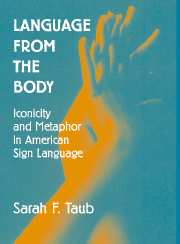Book contents
- Frontmatter
- Contents
- List of Figures
- Acknowledgments
- 1 A Glimpse of the Material
- 2 Motivation and Linguistic Theory
- 3 Iconicity Defined and Demonstrated
- 4 The Analogue-Building Model of Linguistic Iconicity
- 5 Survey of Iconicity in Signed and Spoken Languages
- 6 Metaphor in American Sign Language: The Double Mapping
- 7 Many Metaphors in a Single Sign
- 8 The Vertical Scale as Source Domain
- 9 Verb Agreement Paths in American Sign Language
- 10 Complex Superposition of Metaphors in an American Sign Language Poem
- 11 The Future of Signed-Language Research
- Appendix 1 Glossing Conventions
- Appendix 2 Translation of “The Treasure”
- References
- Index
4 - The Analogue-Building Model of Linguistic Iconicity
Published online by Cambridge University Press: 16 October 2009
- Frontmatter
- Contents
- List of Figures
- Acknowledgments
- 1 A Glimpse of the Material
- 2 Motivation and Linguistic Theory
- 3 Iconicity Defined and Demonstrated
- 4 The Analogue-Building Model of Linguistic Iconicity
- 5 Survey of Iconicity in Signed and Spoken Languages
- 6 Metaphor in American Sign Language: The Double Mapping
- 7 Many Metaphors in a Single Sign
- 8 The Vertical Scale as Source Domain
- 9 Verb Agreement Paths in American Sign Language
- 10 Complex Superposition of Metaphors in an American Sign Language Poem
- 11 The Future of Signed-Language Research
- Appendix 1 Glossing Conventions
- Appendix 2 Translation of “The Treasure”
- References
- Index
Summary
THE ANALOGUE-BUILDING MODEL: IMAGE SELECTION, SCHEMATIZATION, AND ENCODING
The examples of Chapter Three have demonstrated that both signed and spoken languages have iconicity, and that iconicity manifests not only at the lexical level but also at morphological and syntactic levels. This is enough to show that form–meaning resemblance should be included on the list of phenomena that all reasonable linguistic theories explain. Other questions about iconicity immediately arise. How are iconic items created? How is the form–meaning resemblance modeled in users' minds? Are new iconic items created on-line? How does iconicity interact with other ways in which meaning motivates form? This chapter proposes answers to some of these questions.
The purpose of this chapter is to provide a general framework and a set of tools for precise description, modeling, and analysis of iconic linguistic items. As we shall see, this framework can be applied equally well to iconicity in either the spoken or signed modality and at any level of linguistic structure. The fact that iconicity is more common in the signed modality is a simple consequence of this framework as well.
To model iconicity fully, we need to talk both about structure-preserving mappings of meaning onto form and about creation of particular forms (“analogues”) that are amenable to such mappings. In most iconic items, we create an analogue of the referent's image out of the phonetic “stuff” of our language: sounds, movements, shapes. How exactly do we determine the form of that “stuff”?
- Type
- Chapter
- Information
- Language from the BodyIconicity and Metaphor in American Sign Language, pp. 43 - 62Publisher: Cambridge University PressPrint publication year: 2001



